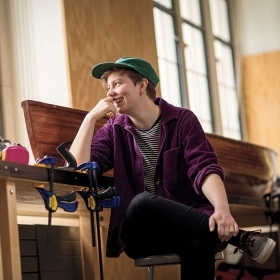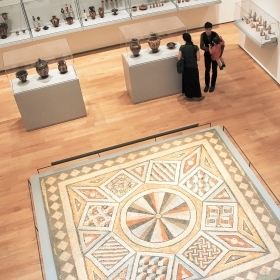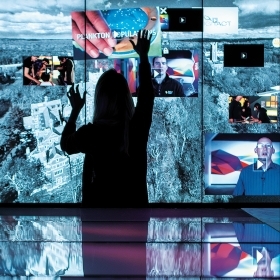When I step outside Green Hall these days, I see the beautifully transformed arts center across the Academic Quad in Pendleton West. Engraved in stone above what was the main entry to the 1935 building...
When I step outside Green Hall these days, I see the beautifully transformed arts center across the Academic Quad in Pendleton West. Engraved in stone above what was the main entry to the 1935 building remains the word “Chemistry,” a reminder of the department that once resided here, an echo of the past. But there are other resonances in that word that tell a story about the arts at Wellesley. First, chemistry is the study of the transformations that substances undergo. And it also refers to “an interaction between people working together with harmony.” These twin ideas of transformation and harmonious collaboration (along with our tradition of excellence, that echo of the past) define Wellesley’s rich, diverse arts and cultural life.
When I think of arts at Wellesley, I think of our iconic midcentury-modern gem, the beloved Jewett Arts Center, as partner to the new Pendleton West—with artists crossing both a real bridge and intellectual and programmatic bridges as they interact with and influence each other. I think, too, of the riches of our widely admired Davis Museum. And I think of the shining creativity and vision of our students and faculty.
What makes Wellesley a leader in arts pedagogy and study can be found in each of these examples. What makes us stand out is how we work together at the intersections of shared knowledge and engage with the world as we strive to change it for the better.
Consider, first, all that has been gained by the new sphere of artistic practice and scholarship with Pendleton West’s transformation and its integration of the arts—music, art, cinema and media studies, and media arts and sciences. Pendleton’s top-to-bottom renovation brings together disciplines with shared needs, sparking both planned and serendipitous projects and conversations, and encouraging new connections between traditional practices and emerging technologies along the way. (For more on Pendleton, see “The Art of Connection.”)
We need only look steps away, to the Davis, for a compelling example of how art at Wellesley helps illuminate world issues. In February, the Davis removed or cloaked art created by artists who were immigrants or donated by collectors who immigrated to the United States. By showing what was lost in this way, “Art-Less” (as it was called) became a powerful example in the ongoing debate of the debt our society owes immigrants. And it articulated, with great poignancy, a core Wellesley value: that we better ourselves by engaging with perspectives and worldviews of all kinds.
Our students and faculty themselves, however, are our greatest example of the power and purpose of the arts at Wellesley. Their collaboration and study, often cross-disciplinary, addresses real-world problems while honing the highest levels of artistic skill. In our Human-Computer Interaction Laboratory, for example, faculty have worked with students to merge design artistry and computer science to create next-generation human-computer interfaces (including virtual and augmented reality) that advance scientific discovery and learning. For a project called Holomuse, students test an augmented reality device that enables users to examine and curate their own exhibits using 3D scanned artifacts from the Davis and the British Museum, enhancing the museum experience.
Our artists touch and interact with so much of campus beyond their studios. In May, the art department’s annual senior theses group exhibition took place in multiple spaces in the Jewett Arts Center, with a film screening in Pendleton West and a satellite installation in the Margaret C. Ferguson Greenhouses. These artists reject silos; they major in studio art as well as art history, chemistry, media arts and sciences, classics, and cinema and media studies. Audrey Stevens ’17, who screened her film about women’s mental health, said, “Film is a different reality that we can enter,” one reality full of endless possibilities. I can think of no better definition for the arts at Wellesley.
Now more than ever, we need to be open to the unfamiliar, to sharing different ideas. Art, as it always has been, must be a source of inspiration across our campus. By unleashing the transformative, collaborative, and visionary power of the arts at Wellesley, we celebrate art’s ability to connect us to the larger world and to clarify how we understand that world, and ourselves. That’s a beautiful kind of chemistry.


